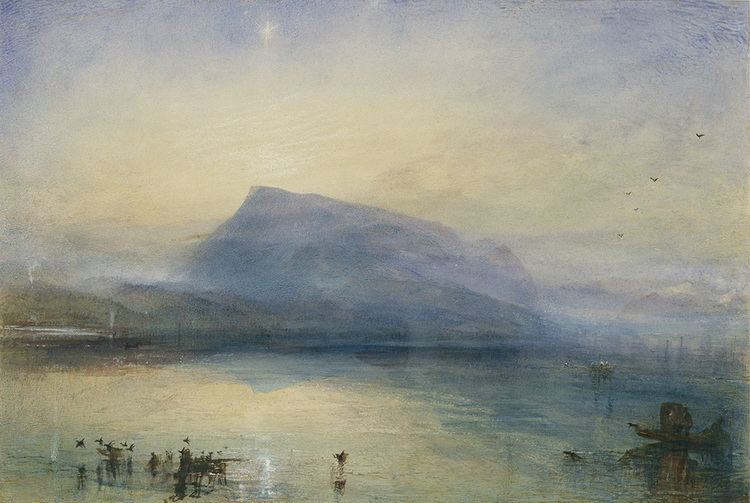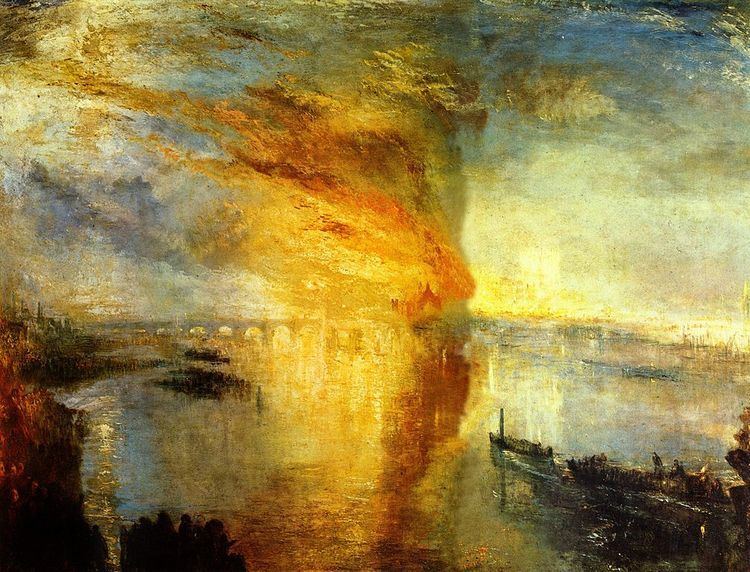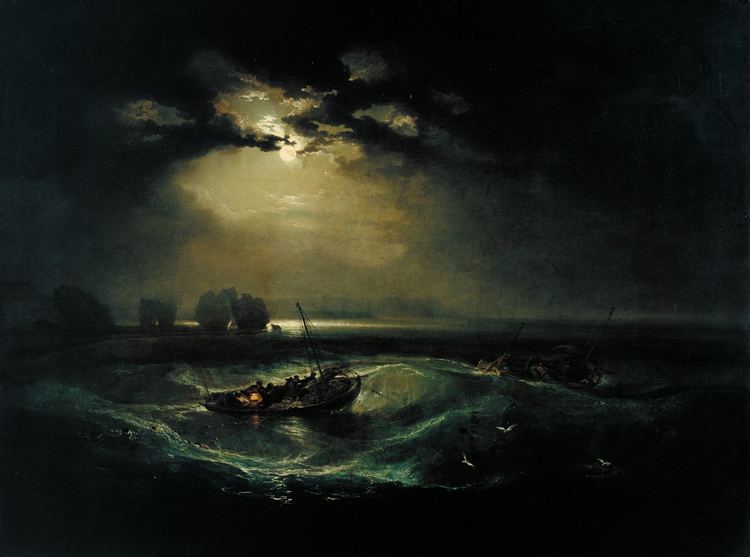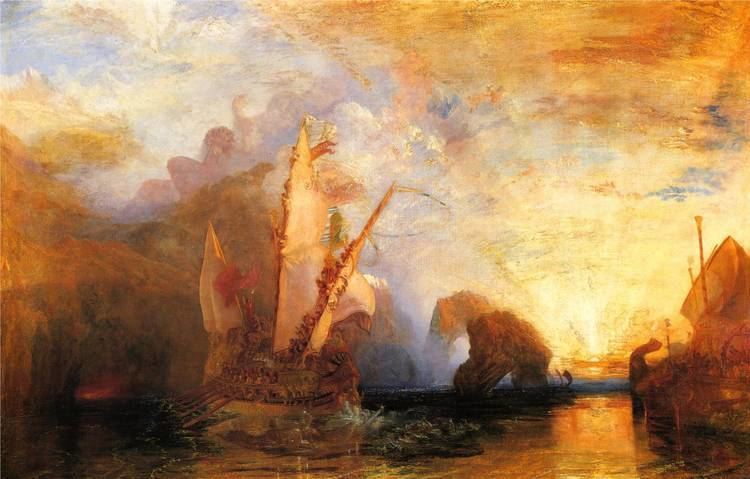Nationality English Name J. W. Role Painter | Known for Painting Fields Painting | |
 | ||
Full Name Joseph Mallord William Turner Born c. late April – early May 1775; baptised 14 May Covent Garden, London, England Series Light and Colour and Shade and Darkness Parents William Turner, Mary Marshall Artwork The Fighting Temeraire, Rain - Steam and Speed, The Slave Ship, Snow Storm: Hannibal, Snow Storm: Steam‑Bo Similar People John Constable, Timothy Spall, Eugene Delacroix, Caspar David Friedrich, Claude Monet | ||
J M W Turner (1775-1850) volume one - a collection of paintings 4K
Joseph Mallord William Turner, RA (23 April 1775 – 19 December 1851) was an English Romantic painter, printmaker and watercolourist, known for his brilliant, expressive colourisation, imaginative landscapes and turbulent, often violent marine paintings.
Contents
- J M W Turner 1775 1850 volume one a collection of paintings 4K
- J M W Turner 1775 1851 The Sun Is God
- Early life
- Royal Academy
- Early career
- Personal life
- Death
- Style
- Materials
- Legacy
- Portrayal in theatre television and film
- Selected works
- References

He was born in Maiden Lane, Covent Garden, London, to a modest lower middle-class family. He lived in London all his life, retaining his Cockney accent and assiduously avoiding the trappings of success and fame. A child prodigy, Turner studied at the Royal Academy of Arts from 1789, enrolling when he was 14, and exhibited his first work there at 21. During this period, he also served as an architectural draftsman. Thereafter he earned a steady income from commissions and sales, which due to his troubled, contrary nature, were often begrudgingly accepted. He opened his own gallery in 1804 and became professor of perspective at the Academy in 1807, where he lectured until 1828. He traveled to Europe from 1802, typically returning with voluminous sketchbooks.

Turner was an intensely private, eccentric and reclusive man. He was a controversial figure throughout his career; he did not marry, but fathered two daughters, Eveline and Georgian, by his housekeeper Hannah (Sarah) Danby. He became more pessimistic and morose as he got older, especially after the death of his father, after which his life deteriorated, and his gallery fell into disrepair and neglect. He lived in poor health from 1845, dying in London in 1851 aged seventy-six. He is buried in Saint Paul's Cathedral, London.

He left behind over 2,000 paintings and 19,000 drawings and sketches. He had been championed by the leading English art critic John Ruskin from 1840, and is today regarded as having elevated landscape painting to an eminence rivaling history painting. Widely considered one of the greatest masters of British watercolour landscape and marine painting, he is sometimes referred to as "the painter of light". A deeply experimental and progressive artist, his influence can be found in the works of painters as diverse as Claude Monet and Mark Rothko.

J M W Turner 1775-1851 "The Sun Is God"
Early life

Joseph Mallord William Turner was born on 23 April 1775 and baptised on 14 May. He was born in Maiden Lane, Covent Garden, in London, England. His father, William Turner (1745–21 September 1829), was a barber and wig maker. His mother, Mary Marshall, came from a family of butchers. A younger sister, Mary Ann, was born in September 1778 but died in August 1783.
In 1785, due to his mother showing signs of the mental disturbance for which she was admitted first to St Luke's Hospital for Lunatics in Old Street in 1799 and then Bethlem Hospital in 1800, where she died in 1804, the young Turner was sent to stay with his maternal uncle, Joseph Mallord William Marshall, in Brentford, then a small town on the banks of the River Thames west of London. The earliest known artistic exercise by Turner is from this period—a series of simple colourings of engraved plates from Henry Boswell's Picturesque View of the Antiquities of England and Wales.
Around 1786, Turner was sent to Margate on the north-east Kent coast. Here he produced a series of drawings of the town and surrounding area foreshadowing his later work. Turner returned to Margate many times in later life. By this time, Turner's drawings were being exhibited in his father's shop window and sold for a few shillings. His father boasted to the artist Thomas Stothard that: "My son, sir, is going to be a painter." In 1789, Turner again stayed with his uncle who had retired to Sunningwell in Berkshire (now part of Oxfordshire). A whole sketchbook of work from this time in Berkshire survives as well as a watercolour of Oxford. The use of pencil sketches on location, as the foundation for later finished paintings, formed the basis of Turner's essential working style for his whole career.
Many early sketches by Turner were architectural studies or exercises in perspective, and it is known that, as a young man, he worked for several architects including Thomas Hardwick, James Wyatt and Joseph Bonomi the Elder. By the end of 1789, he had also begun to study under the topographical draughtsman Thomas Malton, specialised in London views. Turner learned from him the basic tricks of the trade, copying and colouring outline prints of British castles and abbeys. He would later call Malton "My real master". Topography was a thriving industry by which a young artist could pay for his studies.
Royal Academy
He entered the Royal Academy of Art in 1789, aged of 14, and was accepted into the academy a year later. Sir Joshua Reynolds, president of the Royal Academy, chaired the panel that admitted him. At first Turner showed a keen interest in architecture, but was advised by the architect Thomas Hardwick to continue painting. His first watercolour painting A View of the Archbishop's Palace, Lambeth was accepted for the Royal Academy summer exhibition of 1790 when Turner was 15.
As a probationer in the academy, he was taught drawing from plaster casts of antique sculptures. From July 1790 to October 1793, his name appears in the registry of the academy over a hundred times. In June 1792, he was admitted to the life class to learn to draw the human body from nude models. Turner exhibited watercolours each year at the academy while painting in the winter and travelling in the summer widely throughout Britain, particularly to Wales, where he produced a wide range of sketches for working up into studies and watercolours. These particularly focused on architectural work, which utilised his skills as a draughtsman. In 1793, he showed the watercolour titled The Rising Squall – Hot Wells from St Vincent's Rock Bristol (now lost), which foreshadowed his later climatic effects. Cunningham in his obituary of Turner wrote that it was: "recognised by the wiser few as a noble attempt at lifting landscape art out of the tame insipidities...[and] evinced for the first time that mastery of effect for which he is now justly celebrated."
In 1796, Turner exhibited Fishermen at Sea, his first oil painting at the academy, of a nocturnal moonlit scene of the Needles off the Isle of Wight. The image of boats in peril contrasts the cold light of the moon with the firelight glow of the fishermen's lantern. Wilton said that the image: "Is a summary of all that had been said about the sea by the artists of the 18th century." and shows strong influence by artists such as Claude Joseph Vernet, Philip James de Loutherbourg, Peter Monamy and Francis Swaine, who was admired for his moonlight marine paintings. This particular painting cannot be said to show any influence of Willem van de Velde the Younger, as not a single nocturnal scene is known by that painter. Some later work, however, was created to rival or complement the manner of the Dutch artist. The image was praised by contemporary critics and founded Turner's reputation, as both an oil painter and a painter of maritime scenes.
Early career
Turner travelled widely in Europe, starting with France and Switzerland in 1802 and studying in the Louvre in Paris in the same year. He made many visits to Venice.
Important support for his work came from Walter Ramsden Fawkes, of Farnley Hall, near Otley in Yorkshire, who became a close friend of the artist. Turner first visited Otley in 1797, aged 22, when commissioned to paint watercolours of the area. He was so attracted to Otley and the surrounding area that he returned to it throughout his career. The stormy backdrop of Hannibal Crossing The Alps is reputed to have been inspired by a storm over the Chevin in Otley while he was staying at Farnley Hall.
Turner was a frequent guest of George O'Brien Wyndham, 3rd Earl of Egremont, at Petworth House in West Sussex and painted scenes that Egremont funded taken from the grounds of the house and of the Sussex countryside, including a view of the Chichester Canal. Petworth House still displays a number of paintings.
Personal life
As Turner grew older, he became more eccentric. He had few close friends except for his father, who lived with him for 30 years and worked as his studio assistant. His father's death in 1829 had a profound effect on him, and thereafter he was subject to bouts of depression. He never married but had a relationship with an older widow, Sarah Danby. He is believed to have been the father of her two daughters born in 1801 and 1811.
Later, he had a relationship with Sophia Caroline Booth after her second husband died, living for about 18 years as 'Mr Booth' in her house in Chelsea.
Turner was a habitual user of snuff; in 1838 the King of France, Louis-Philippe, presented a gold snuff box to him. Of two other snuffboxes, an agate and silver example bears Turner's name, and another, made of wood, was collected along with his spectacles, magnifying glass and card case by an associate housekeeper.
Death
Turner died of cholera at the home of his lover Sophia Caroline Booth, in Cheyne Walk in Chelsea, on 19 December 1851. Apparently his last words were "The Sun is God", though this may be apocryphal. He is buried in St Paul's Cathedral, where he lies next to Sir Joshua Reynolds.
Turner's friend, architect Philip Hardwick (1792–1870), son of his tutor, Thomas Hardwick, was in charge of making the funeral arrangements and wrote to those who knew Turner to tell them at the time of his death that, "I must inform you, we have lost him." Other executors were his cousin and chief mourner at the funeral, Henry Harpur IV (benefactor of Westminster – now Chelsea & Westminster – Hospital), Revd. Henry Scott Trimmer, George Jones RA and Charles Turner ARA.
Style
Turner's talent was recognised early in his life. Financial independence allowed Turner to innovate freely; his mature work is characterised by a chromatic palette and broadly applied atmospheric washes of paint. According to David Piper's The Illustrated History of Art, his later pictures were called "fantastic puzzles." Turner was recognised as an artistic genius: influential English art critic John Ruskin described him as the artist who could most "stirringly and truthfully measure the moods of Nature."
In his own time his work also met with criticism from more traditional contemporaries for its unique style, in particular Sir George Beaumont, a landscape painter and fellow member of the Royal Academy, who described his paintings as 'blots'.
Suitable vehicles for Turner's imagination were found in shipwrecks, fires (such as the burning of Parliament in 1834, an event which Turner rushed to witness first-hand, and which he transcribed in a series of watercolour sketches), natural catastrophes, and natural phenomena such as sunlight, storm, rain, and fog. He was fascinated by the violent power of the sea, as seen in Dawn after the Wreck (1840) and The Slave Ship (1840).
Turner's major venture into printmaking was the Liber Studiorum (Book of Studies), seventy prints that he worked on from 1806 to 1819. The Liber Studiorum was an expression of his intentions for landscape art. The idea was loosely based on Claude Lorrain's Liber Veritatis (Book of Truth), where Claude had recorded his completed paintings; a series of print copies of these drawings, by then at Devonshire House, had been a huge publishing success. Turner's plates were meant to be widely disseminated, and categorised the genre into six types: Marine, Mountainous, Pastoral, Historical, Architectural, and Elevated or Epic Pastoral. His printmaking was a major part of his output, and a museum is devoted to it, the Turner Museum in Sarasota, Florida, founded in 1974 by Douglass Montrose-Graem to house his collection of Turner prints.
Turner placed human beings in many of his paintings to indicate his affection for humanity on the one hand (note the frequent scenes of people drinking and merry-making or working in the foreground), but its vulnerability and vulgarity amid the 'sublime' nature of the world on the other. 'Sublime' here means awe-inspiring, savage grandeur, a natural world unmastered by man, evidence of the power of God – a theme that romanticist artists and poets were exploring in this period. To Turner, light was the emanation of God's spirit and this was why he focused the subject matter of his later paintings by leaving out distractions such as solid objects and detail, concentrating on the play of light on water, the radiance of skies and fires. Although these late paintings appear to be 'impressionistic' and therefore a forerunner of the French school, Turner was striving for expression of spirituality in the world, rather than responding primarily to optical phenomena.
His early works, such as Tintern Abbey (1795), stayed true to the traditions of English landscape. However, in Hannibal Crossing the Alps (1812), an emphasis on the destructive power of nature had already come into play. His distinctive style of painting, in which he used watercolour technique with oil paints, created lightness, fluency, and ephemeral atmospheric effects.
In his later years he used oils ever more transparently, and turned to an evocation of almost pure light by use of shimmering colour. A prime example of his mature style can be seen in Rain, Steam and Speed – The Great Western Railway, where the objects are barely recognisable. The intensity of hue and interest in evanescent light not only placed Turner's work in the vanguard of English painting, but exerted an influence on art in France; the Impressionists, particularly Claude Monet, carefully studied his techniques.
High levels of volcanic ash (from the eruption of Mt. Tambora) in the atmosphere during 1816, the "Year Without a Summer", led to unusually spectacular sunsets during this period, and were an inspiration for some of Turner's work.
John Ruskin says in his "Notes" on Turner in March 1878, that an early patron, Dr Thomas Monro, the Principal Physician of Bedlam, and also a collector and amateur artist, was a significant influence on Turner's style:
His true master was Dr Monro; to the practical teaching of that first patron and the wise simplicity of method of watercolour study, in which he was disciplined by him and companioned by his friend Girtin, the healthy and constant development of the greater power is primarily to be attributed; the greatness of the power itself, it is impossible to over-estimate.
Together with a number of young artists Turner was able, in the London house of Dr. Monro, to copy works of the major topographical draughtsmen of his time and perfect his skills in drawing. But the curious atmospherical effects and illusions of the watercolours of John Robert Cozens, some of which were present in Monro's house, went far further than the neat renderings of topography. The solemn grandeur of his Alpine views were an early revelation to the young artist and showed him the true potential of the watercolour medium, conveying mood instead of information.
On a trip to Europe, circa 1820, he met the Irish physician Robert James Graves. Graves was travelling in a diligence in the Alps when a man who looked like the mate of a ship got in, sat beside him, and soon took from his pocket a note-book across which his hand from time to time passed with the rapidity of lightning. Graves wondered if the man was insane, he looked, saw that the stranger had been noting the forms of clouds as they passed and that he was no common artist. The two travelled and sketched together for months. Graves tells that Turner would outline a scene, sit doing nothing for two or three days, then suddenly, "perhaps on the third day, he would exclaim 'there it is', and seizing his colours work rapidly till he had noted down the peculiar effect he wished to fix in his memory."
The first American to buy a Turner painting was James Lenox of New York City, a private collector. Lenox wished to own a Turner and in 1845 bought one unseen through an intermediary, his friend C. R. Leslie. From among the paintings Turner had on hand and was willing to sell for £500, Leslie selected and shipped the 1832 atmospheric seascape Staffa, Fingal's Cave. Worried about the painting's reception by Lenox, who knew Turner's work only through etchings, Leslie wrote to Lenox that the quality of Staffa, "a most poetic picture of a steam boat" would become apparent in time. On receiving the painting Lenox was baffled, and "greatly disappointed" by what he called the painting's "indistinctness". When Leslie was forced to relay this opinion to Turner, Turner said "You should tell Mr Lenox that indistinctness is my forte." Staffa, Fingal's Cave is now owned by the Yale Center for British Art.
Materials
Turner used or experimented with a wide variety of pigments, using several within a few years of their dates of discovery. Turner used pigments like carmine in his paintings, despite knowing that they were not long-lasting, and against the advice of contemporary experts to use more durable pigments. As a result, many of his colours have now faded. John Ruskin complained at how quickly Turner's work decayed; Turner was indifferent to posterity and chose materials that looked good when freshly applied. By 1930 there was concern that both his oils and his watercolours were fading.
Legacy
Turner left a small fortune which he hoped would be used to support what he called "decayed artists". He planned and designed an almshouse for them at Twickenham with a gallery for some of his works. His will was contested and in 1856, after a court battle, his first cousins, including Thomas Price Turner, received part of his fortune. Another portion went to the Royal Academy of Arts, which occasionally awards students the Turner Medal. His collection of finished paintings was bequeathed to the British nation, and he intended that a special gallery would be built to house them. This did not happen because of a failure to agree on a site, and the parsimony of British governments. Twenty-two years after his death, the British Parliament passed an act allowing his paintings to be lent to museums outside London, and so began the process of scattering the pictures which Turner had wanted to be kept together.
In 1910, the main part of the Turner Bequest, which includes unfinished paintings and drawings, was rehoused in the Duveen Turner Wing at the National Gallery of British Art (now Tate Britain). In 1987, a new wing at the Tate, the Clore Gallery, was opened to house the Turner bequest, though some of the most important paintings remain in the National Gallery in contravention of Turner's condition that they be kept and shown together. Increasingly paintings are lent abroad, ignoring Turner's provision that they remain constantly and permanently in Turner's Gallery.
St. Mary's Church, Battersea added a commemorative stained glass window for Turner, between 1976 and 1982. St Paul's Cathedral, Royal Academy of Arts and Victoria & Albert Museum all hold statues representing him. A portrait drawing by Cornelius Varley with his patent graphic telescope (Sheffield Museums & Galleries) was compared with his death mask (National Portrait Gallery, London) by Kelly Freeman at Dundee University 2009–10 to ascertain whether it really depicts Turner. The city of Westminster unveiled a memorial plaque at the site of his birthplace at 21 Maiden Lane, Covent Garden 2 June 1999.
Selby Whittingham founded The Turner Society at London and Manchester in 1975. After the society endorsed the Tate Gallery's Clore Gallery wing (on the lines of the Duveen wing of 1910), as the solution to the controversy of what should be done with the Turner Bequest, Selby Whittingham resigned and founded the Independent Turner Society. The Tate created the prestigious annual Turner Prize art award in 1984, named in Turner's honour, and 20 years later the Royal Institute of Painters in Water Colours founded the Winsor & Newton Turner Watercolour Award. A major exhibition, "Turner's Britain", with material (including The Fighting Temeraire) on loan from around the globe, was held at Birmingham Museum and Art Gallery from 7 November 2003 to 8 February 2004. In 2005, Turner's The Fighting Temeraire was voted Britain's "greatest painting" in a public poll organised by the BBC.
On 22 April 2016, the Bank of England announced that Turner would appear on the next issue of the £20 note, as the result of a selection process to choose a representative from the field of visual arts. The Turner note is due to enter circulation in 2020.
Portrayal in theatre, television and film
Leo McKern played Turner in The Sun is God, a 1974 Thames Television production directed by Michael Darlow. The programme was shown on 17 December 1974, during the Turner Bicentenary Exhibition in London. In January 2011 The Painter, a biographical play on his life by Rebecca Lenkiewicz, premiered at the Arcola Theatre in London. British filmmaker Mike Leigh wrote and directed Mr. Turner, a biopic of Turner's later years, released in 2014. The film starred Timothy Spall as Turner, Dorothy Atkinson, Marion Bailey and Paul Jesson, and premiered in competition for the Palme d'Or at the 2014 Cannes Film Festival, with Spall taking the award for Best Actor.
Selected works
Turner was an extremely prolific artist who produced more than 550 oil paintings, 2,000 watercolours, and 30,000 paper works. The Tate Gallery in London produces the most comprehensive and up to date catalogue of Turner works held in both public and private collections worldwide.
